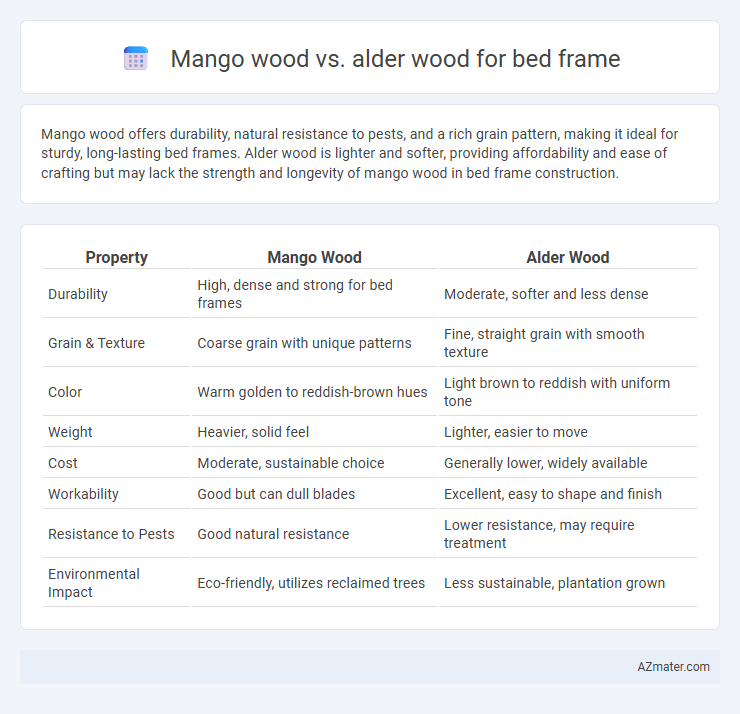Mango wood offers durability, natural resistance to pests, and a rich grain pattern, making it ideal for sturdy, long-lasting bed frames. Alder wood is lighter and softer, providing affordability and ease of crafting but may lack the strength and longevity of mango wood in bed frame construction.
Table of Comparison
| Property | Mango Wood | Alder Wood |
|---|---|---|
| Durability | High, dense and strong for bed frames | Moderate, softer and less dense |
| Grain & Texture | Coarse grain with unique patterns | Fine, straight grain with smooth texture |
| Color | Warm golden to reddish-brown hues | Light brown to reddish with uniform tone |
| Weight | Heavier, solid feel | Lighter, easier to move |
| Cost | Moderate, sustainable choice | Generally lower, widely available |
| Workability | Good but can dull blades | Excellent, easy to shape and finish |
| Resistance to Pests | Good natural resistance | Lower resistance, may require treatment |
| Environmental Impact | Eco-friendly, utilizes reclaimed trees | Less sustainable, plantation grown |
Overview: Mango Wood vs Alder Wood
Mango wood is a dense hardwood known for its durability, rich grain patterns, and sustainability, making it ideal for eco-friendly bed frames with natural character. Alder wood is a softer hardwood with a smooth texture and lighter color, offering a more affordable option while still providing reasonable strength and ease of finishing. Both woods balance aesthetics and function, but mango wood generally provides greater longevity and resistance to wear compared to alder wood in bed frame construction.
Origin and Sustainability
Mango wood, sourced primarily from India and Southeast Asia, is a sustainable choice due to its use of trees that have completed their fruit-bearing cycle, minimizing deforestation. Alder wood originates from North America and parts of Europe, harvested from fast-growing trees that help support forest regeneration efforts. Both woods offer eco-friendly benefits, but mango wood's repurposing of mature trees often results in a lower environmental impact for bed frames.
Appearance and Grain Patterns
Mango wood features a rich, warm hue with golden to reddish-brown tones, showcasing unique, irregular grain patterns that add a rustic and exotic charm to bed frames. Alder wood presents a more uniform, smooth texture with a lighter, creamy color and subtle, straight grain patterns, offering a clean and minimalist aesthetic. Choosing between mango and alder wood depends on whether the preference is for vibrant, striking grain variations or a consistent, understated look in bed frame design.
Durability and Strength Comparison
Mango wood offers superior durability and strength compared to alder wood, making it a preferred choice for bed frames that require long-lasting support. Its dense grain structure and natural hardness provide excellent resistance to wear, while alder wood tends to be softer and more prone to dents and scratches. For bed frames, mango wood's robustness ensures better stability and longevity under regular use.
Weight and Workability
Mango wood is heavier and denser than alder wood, providing a robust and durable bed frame that resists wear and tear over time. Alder wood, being lighter and softer, offers superior workability, allowing for easier carving, shaping, and finishing during bed frame construction. Choosing mango wood results in a sturdier frame ideal for longevity, while alder wood benefits projects requiring intricate designs and faster production.
Finishing and Maintenance Needs
Mango wood offers a smooth finish with a natural grain that takes well to stains and polish, creating a rich, warm appearance ideal for bed frames, while its dense composition provides durability with moderate maintenance. Alder wood presents a lighter, uniform texture that easily accepts paint and stain, allowing for versatile finishing options but generally requires more frequent sealing to protect against moisture and wear. Both woods benefit from regular dusting and occasional waxing to preserve their finish, but mango wood tends to resist scratches and blemishes better, reducing long-term upkeep.
Cost and Price Differences
Mango wood offers an affordable option for bed frames, typically priced between $200 and $500, making it a budget-friendly choice compared to alder wood, which ranges from $400 to $800 due to its higher durability and fine grain. The cost difference is influenced by mango wood's rapid growth and sustainability, reducing material expenses, while alder wood's denser texture and easier stain absorption increase manufacturer processing costs. Choosing mango wood bed frames can save approximately 30-50% off alder wood prices, appealing to cost-conscious buyers seeking sturdy, stylish furniture.
Environmental Impact
Mango wood is a sustainable choice for bed frames due to its fast growth cycle and use of ripened mango trees no longer producing fruit, which reduces deforestation. Alder wood, on the other hand, grows relatively quickly but is less commonly sourced from sustainable plantations, leading to higher environmental concerns. Choosing mango wood supports responsible forestry practices and lowers carbon footprint compared to traditional hardwoods like alder.
Suitability for Bed Frames
Mango wood offers high durability and resistance to wear, making it an excellent choice for bed frames that require long-lasting strength and a rich, warm appearance. Alder wood, while softer and lighter, provides a smoother finish and is easier to work with, ideal for intricate designs but less resistant to dents and scratches over time. For bed frames, mango wood's robustness and resistance to moisture make it more suitable for heavy use and longevity compared to alder wood.
Pros and Cons Summary
Mango wood offers durability, rich grain patterns, and eco-friendliness due to its fast growth, making it a sustainable choice for bed frames. Alder wood features a smooth texture and lighter weight but is less resistant to dents and scratches compared to mango wood. Mango wood tends to be harder and more moisture-resistant, while alder wood is easier to work with and generally more affordable.

Infographic: Mango wood vs Alder wood for Bed frame
 azmater.com
azmater.com